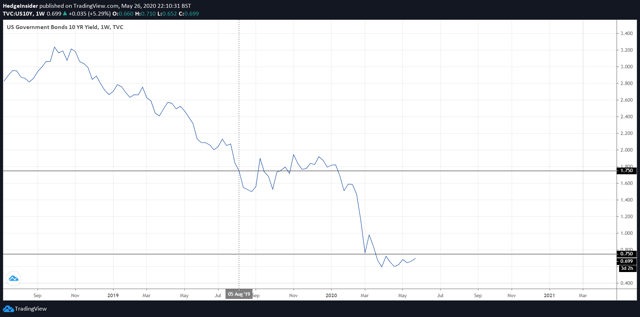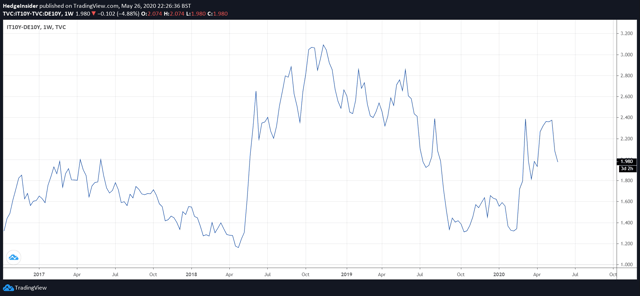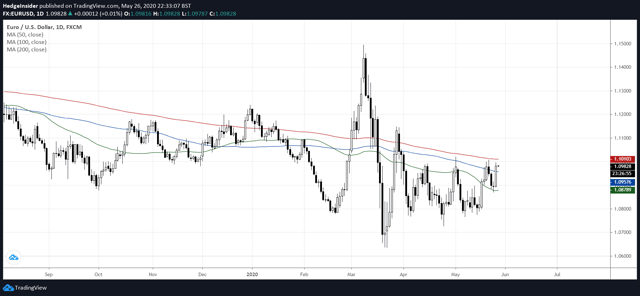EUR/USD Volatility May Fall, Yet Bearish Trend Remains Intact
by Hedge InsiderSummary
- Markets are now rallying as global risk sentiment improves.
- Liquidity remains high, while interest rates have been cut across the world (in response to the recent COVID-19 crisis).
- Lower risk-free rates generally mean lower equity risk premiums; this is supporting a rally in U.S. equities, even if short-term earnings take a hit.
- While the EUR/USD interest rate spread is now very tight as a result of the Fed's cut to the zero lower bound (with a target rate of +0.00-0.25%), given that the ECB has been unable to cut its rate (already being in a negative position), we can expect U.S. markets to outperform.
- This outperformance strengthens the case for EUR outflows in favor of USD-denominated assets. However, should optimism in the eurozone increase, volatility is likely to remain lower for EUR crosses. The bearish trend may remain intact, but it may now take longer for EUR crosses to move substantially.
The euro (or EUR) is the second most traded currency in the world, after the U.S. dollar (or USD). USD's share of trading turnover is between two or three times greater than EUR's share, however, this is not surprising since USD is still considered the world's reserve currency.
While both USD and EUR have large and active FX markets, USD is generally a more common currency to transact through. For example, if a large Australian corporate wanted to convert AUD 100 million into NZD, it might sell AUD/USD and use the proceeds to buy NZD/USD, rather than transact directly through the AUD/NZD cross (which is likely to be far less liquid).
The euro is liquid too, however, and this has in the past been helped by its 'funding currency' characteristics. A funding currency is usually a currency which carries either a low or negative interest rate, and is also liquid, and hence makes for an attractive currency to sell in order to fund purchases of risk assets. However, funding currencies present risks of their own if they are not also fundamentally bearish themselves. For example, a trader based in the U.S. could face large draw-downs, independent of the performance of the underlying assets purchased, if their short-euro positions (i.e., via the funding mechanism) went south in USD terms (if the euro rallied instead of fell).
Given that global interest rates have fallen drastically this year, with many major central banks including the U.S. Federal Reserve, the Bank of Canada and the Bank of England (to name three) at or close to the zero lower bound. The U.S. Fed's short-term rate is now +0.00-0.25% (target range), whereas the European equivalent (the European Central Bank's deposit facility rate) is still negative at -0.50%. Therefore, while there is still a positive delta in favor of the USD, the margin is now small and makes it unattractive for carry traders to sell euros in exchange for U.S. dollars (at least, the potential for interest income is limited, while the risk of spot prices moving adversely remains).
The euro may continue to operate like a funding currency, but until U.S. rates are able to rise beyond European rates, the appeal (to sell EUR to fund asset purchases) is likely to remain subdued for the foreseeable future. I do not think that U.S. rates will rise during 2020. An important reason for why equities are currently rallying off the lows, in spite of the threats of the COVID-19 crisis, is because not only is liquidity high but interest rates are so low. The low rates feed into measures of the equity risk premium via the risk-free rate (which is usually taken from U.S. treasuries).
Super-low interest rates means that the denominator (under corporate earnings) is lower. For example, say you have a fixed 3% surplus required return over the risk-free rate (i.e., independent of the risk-free rate), for simplicity. Now, in August 2019, the U.S. 10-year treasury yield was priced at a yield of around +1.75%. More recently, it is flirting with a yield of around +0.75% (as the bond market anticipates lower long-term rates, going forward).
The chart below illustrates the 10-year yield; the vertical line marks the beginning of August, while the two horizontal lines draw attention to the +1.75% and +0.75% levels.

(Chart created by the author using TradingView. The same applies to all subsequent price charts presented hereafter.)
If we now return to our 3% risk premium example, the equity risk premium falls from the sum of 3% and +1.75%, to 3% and +0.75%. The difference is therefore between 4.75% and 3.75% (i.e., a drop of 100 basis points in this hypothetical risk premium).
The effect this has on equities is simple. Imagine $100 in corporate earnings, and divide this by the first figure of 4.75%, you get an annualized valuation of $2,105. Now divide $100 into 3.75%, you get $2,667. Simply by reducing the equity risk premium via a substantial reduction in the risk-free rate, we increase the valuation by 27%. These numbers are purely illustrative, but couple this phenomenon with the fact that liquidity remains high and confidence is returning (as the Federal Reserve intervenes), and the other side of the equity risk premium formula might also drop in tandem with lower risk-free rates. (That is, the market may expect a higher return and/or lower volatility.)
Of course, corporate earnings could also drop, but this is likely to be a short-term effect, and markets attempt to discount the entire future (not just the near-term future). The market can see past a short-term crisis, and with lower interest rates, we should fully expect U.S. equities to seek to regain their prior highs. A steady recovery (even if not a so-called V-shaped recovery) could send the S&P 500 (the most popular U.S. equity index) well above their previous highs (just below 3400), even as early as this year.
The Fed is unlikely to raise rates for a while, as this could cause another spiral downward in equities and other assets. Therefore, global rates are likely to remain loose for at least the remainder of 2020, which would help to enable this move. As a result, the spread in short-term EUR/USD rates is likely to remain tight, and therefore the euro is unlikely to be an attractive 'short' from a carry trade perspective.
Yet on the other hand, since the deposit facility rate of the ECB is unchanged, we could actually see U.S. equities continue to outperform European equities longer term. That is, because U.S. rates have been cut (reducing the equity risk premium) while the ECB has been unable to do so (with rates already in the negative). This could put pressure on the euro longer term via exports of investment capital to favor the U.S. market. Should sentiment continue to improve, this trend could strengthen over time.
Another aspect of the euro is political stability. The rise in the spread between Italian and German government bonds recently has been bearish for the euro, since it is the bond market's way of expressing the risk of Italian fiscal sustainability.

(The spread between the Italian 10-year yield and German 10-year yield has risen through 2020 and concerns over the fiscal sustainability of Italy have grown.)
There is also the risk of Brexit throughout 2020. Frankly, because of the size of Europe, there is always a threat of some sort, but the threats of Italy and Brexit are enough to have the euro drifting lower in the medium term. On the other hand, the Italian-German 10-year yield spread (as shown in the chart above) does seem to be falling. Therefore, while the euro may well remain in a downward trend, more optimism on the Italian front (and/or on the Brexit trade negotiations front, with the United Kingdom) may well help to stem EUR outflows.
In short, I believe that the EUR/USD trend is likely to remain bearish (as shown in the chart below; the 200-day moving average in red is above the blue line, the 100-day moving average, which is in turn above the 50-day moving average in green). However, in spite of my generally bearish view, the fact that global rates are now close (if not at) the so-called zero lower bound, and given that the Italian-German yield spread is being compressed by the bond market, we may actually see the euro some short-term upside in EUR/USD.

It would appear that EUR/USD may in fact trade in a less volatile fashion going forward, since there are some medium-term pros and cons for the 'common currency', which together may help to prevent an escalation of the bearish trend to the parity level (i.e., the 1.00 level, which many traders have called for in the past).
No doubt, there are risks of a reversal here. A spike in the Italian-German yield spread, or a break-down in Brexit negotiations, or some other Black Swan-type political crisis in the eurozone that surfaces could escalate the euro's downside. However, as market sentiment is generally improving, I would vote instead for a more gradual decline in the value of the euro, mostly as I expect U.S. markets to outperform European markets. If this does come to pass, we might also see a gradual increase in the use of EUR as a funding currency (once again), in spite of the now much tighter EUR/USD interest rate spread. This would help to support the bearish trend further.
Disclosure: I/we have no positions in any stocks mentioned, and no plans to initiate any positions within the next 72 hours. I wrote this article myself, and it expresses my own opinions. I am not receiving compensation for it (other than from Seeking Alpha). I have no business relationship with any company whose stock is mentioned in this article.